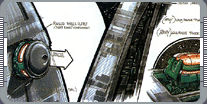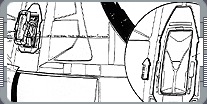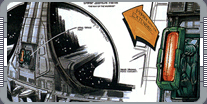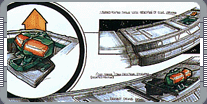
Arming Deep Space Nine - By John Eaves.
In the final scenes of the feature-length episode 'The Way of the Warrior,' Deep
Space 9 engaged in a full-scale battle with the Klingon fleet, revealing that dozens of new weapons were
concealed around its structure.
 When John Eaves joined the Star Trek: Deep Space Nine art department in 1995, one of the first jobs he
was given was to upgrade the station's weaponary so that it could withstand an assault from a fleet of
Klingon ships. Having just arrived, Eaves wasn't all familiar with Star Trek, but he says his boss,
production designer Herman Zimmerman, didn't seem too concerned. "They just said, 'Here's the station'!
I had done a couple of movies before, so Herman figured I knew all I needed to know; he just said, 'Do
the armaments.'"
When John Eaves joined the Star Trek: Deep Space Nine art department in 1995, one of the first jobs he
was given was to upgrade the station's weaponary so that it could withstand an assault from a fleet of
Klingon ships. Having just arrived, Eaves wasn't all familiar with Star Trek, but he says his boss,
production designer Herman Zimmerman, didn't seem too concerned. "They just said, 'Here's the station'!
I had done a couple of movies before, so Herman figured I knew all I needed to know; he just said, 'Do
the armaments.'"
According to the script for 'The Way of the Warrior,' the station's weapons had been massively upgraded
since Starfleet took control. However, because the model of Deep Space Nine had already been built and
several effects sequences (which were used regularly) had been shot at great expense, there was no
question of altering the station in any significant way. This meant that Eaves had to work with the
weapons that had already been designed and find ways of revealing more weapons that were normally
 concealed in the structure. Up to this point, the station hadn't been involved in an all-out battle, so
very little had been established about the existing weapons. Eaves was clear about one thing, though;
they wouldn't provide enough firepower to satify the producers. "Right on that inner ring there are
those tiny curved deals that kind of mimic the larger pylons. Those were the original little defense
sails. I don't think they had ever fired them before that show, and when it came to that episode they
wouldn't suffice for what they wanted to do - they were almost too small."
concealed in the structure. Up to this point, the station hadn't been involved in an all-out battle, so
very little had been established about the existing weapons. Eaves was clear about one thing, though;
they wouldn't provide enough firepower to satify the producers. "Right on that inner ring there are
those tiny curved deals that kind of mimic the larger pylons. Those were the original little defense
sails. I don't think they had ever fired them before that show, and when it came to that episode they
wouldn't suffice for what they wanted to do - they were almost too small."
Before Eaves settled down to design the new weapons, he consulted the visual effects department who would
have to make his drawings into reality. "They said, 'Don't make too many,' because they'd have to show
them firing all the time. I just broke it up into groups of three because that's how the station is
configured." He adds that the VFX team also told him he only needed to design phaser arrays. "For
effects, they could have photon tubes wherever they wanted, because they wouldn't necessarily have to
 show any ports for them. That was more a budget thing; if we showed the ports we would have had to put
them on the station, and since the model already existed they would have to add them. It was such an
elaborate show that they just had them fire off when they gave the verbal command, and we didn't really
see a specific source they fired from."
show any ports for them. That was more a budget thing; if we showed the ports we would have had to put
them on the station, and since the model already existed they would have to add them. It was such an
elaborate show that they just had them fire off when they gave the verbal command, and we didn't really
see a specific source they fired from."
Eaves decided that most of the weapons would either pop out of the structure or emerge from behind
hatches. The station's heavily textured surface lent itself to this approach, but he had to make sure
that he didn't accidentally use a piece of equipment whose function had already been established.
Fortunately, he says, he could turn to an expert for some help. "Mike Okuda knew all the technical
layout of the station, so I'd look at his drawings and go, 'What about putting that there and there.'
On that little inner ring. I didn't know that was where the runabout bays were, so he showed me so I
could put stuff on the towers - they were just for docking. He show me where the they wouldn't disturb
what already existed." When they filmed the weapons appearing, the effects team built small sections of
 the station that showed the relevant areas in detail. This meant that Eaves could make subtle changes to
the texture of the station.
the station that showed the relevant areas in detail. This meant that Eaves could make subtle changes to
the texture of the station.
"I'd look at what was there and work around it. I kind of made up a couple of things; I went with what
was existing and just manipulated the cut lines. There was a panel detail that I made a door out of.
They didn't alter the giant space station model, they just made insert pieces; you never really get a
reference to go back and forth with visually. So we'd go, 'This door is here and we'll do it on our
drawing in the future,' but we didn't alter the big model." In the end, Eaves designed phaser emitters
for the tops and bottoms of the docking pylons, pop-out sections in the middle of them, and oblong phaser
arrays that emerged from platforms next to the runabout bays. In each case, the design evolved as the
show progressed. For example, he remembers that there were two versions of the guns on the ends of the
pylons. "The top of the pylon is a kind of plateau, then it angles down the curve of the spire; I had
one that crossed that line. You would have a top-facing gun, then it would bend down and you'd have a
vertical gun coming off that. Then there was one that was just a flat gun that came off the top. I
think they used the flat one." The units next to the runabout bays also went through some changes.
"That was mostly a scale problem. The first one that comes out has a radar dish look to it, with two
 guns on it. It's real big and chunky, and was too big for the scale. We just funneled it back down to
match the ones I had already done on the pylon. It was also that they wanted to show the weapons were
all along the same lines. They all looked like they had bread in them, like a bread pan in a way; that's
the main shape that come out of it."
guns on it. It's real big and chunky, and was too big for the scale. We just funneled it back down to
match the ones I had already done on the pylon. It was also that they wanted to show the weapons were
all along the same lines. They all looked like they had bread in them, like a bread pan in a way; that's
the main shape that come out of it."
Eaves also took the opportunity to upgrade the weapons sails, adding a cylindrical unit that popped out
of the side. In the finished version this rotated, firing bursts of phaser fire in different directions,
but Eaves says he can't take credit for this innovation. "It was a visual effects decision; having that
roll just added action to the scene. I'm used to the big phaser rings on the ships, and the emitting
surface as opposed to a gun barrel. At the meeting they saw the drawing, and it was always interpreted
that it rolled, and I kind of let it go. I thought, 'Well, that's a neat idea, and it gives a little
motion to it too.' It was originally drawn just to come out, and the energy that would fire would just
roll around it and fire wherever it needed to. It was an effects decision to make the whole thing roll
and fire out of little precise areas."
 The VFX team also suggested a modification to the large pop-out units on the docking pylons. Again Eaves
had simply intended thse to be phaser emitters, but they converted them into more powerful microtorpedo
launchers. "There's a little section right in the center, a detail like a diamond shape, and the effects
team said, 'Ooh, we could use this for a torpedo launcher.' It just kind of happened when we turned the
drawings into the meeting and everyone had a little input. The effects guys said we could do this or
that, we could add a door there." All in all, Eaves say his first major job went very smoothly, and he
was pleased with the station's new weapons. And as soon as he'd finished he took a deep breath and went
straight on to the next show.
The VFX team also suggested a modification to the large pop-out units on the docking pylons. Again Eaves
had simply intended thse to be phaser emitters, but they converted them into more powerful microtorpedo
launchers. "There's a little section right in the center, a detail like a diamond shape, and the effects
team said, 'Ooh, we could use this for a torpedo launcher.' It just kind of happened when we turned the
drawings into the meeting and everyone had a little input. The effects guys said we could do this or
that, we could add a door there." All in all, Eaves say his first major job went very smoothly, and he
was pleased with the station's new weapons. And as soon as he'd finished he took a deep breath and went
straight on to the next show.
|
|
"ARMING DEEP SPACE NINE" - SEPTEMBER 2000 ISSUE 17 STAR TREK: THE MAGAZINE COPYRIGHT 2006 OF PARAMOUNT PICTURES.
|